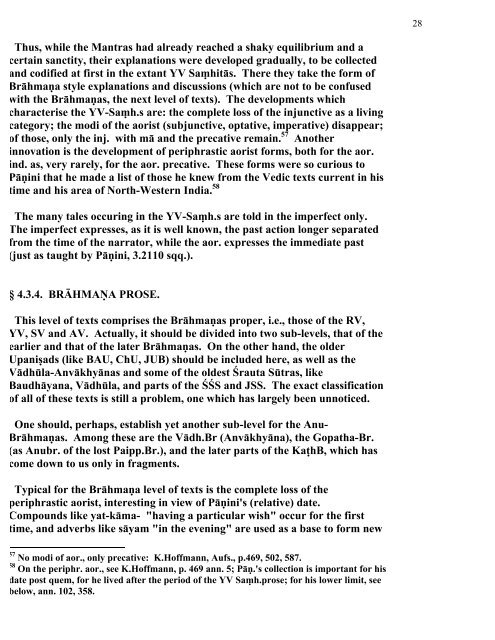TRACING VEDIC DIALECTS - People.fas.harvard.edu
TRACING VEDIC DIALECTS - People.fas.harvard.edu
TRACING VEDIC DIALECTS - People.fas.harvard.edu
Create successful ePaper yourself
Turn your PDF publications into a flip-book with our unique Google optimized e-Paper software.
Thus, while the Mantras had already reached a shaky equilibrium and a<br />
certain sanctity, their explanations were developed gradually, to be collected<br />
and codified at first in the extant YV Saṃhitās. There they take the form of<br />
Brāhmaṇa style explanations and discussions (which are not to be confused<br />
with the Brāhmaṇas, the next level of texts). The developments which<br />
characterise the YV-Saṃh.s are: the complete loss of the injunctive as a living<br />
category; the modi of the aorist (subjunctive, optative, imperative) disappear;<br />
of those, only the inj. with mā and the precative remain. 57 Another<br />
innovation is the development of periphrastic aorist forms, both for the aor.<br />
ind. as, very rarely, for the aor. precative. These forms were so curious to<br />
Pāṇini that he made a list of those he knew from the Vedic texts current in his<br />
time and his area of North-Western India. 58<br />
The many tales occuring in the YV-Saṃh.s are told in the imperfect only.<br />
The imperfect expresses, as it is well known, the past action longer separated<br />
from the time of the narrator, while the aor. expresses the immediate past<br />
(just as taught by Pāṇini, 3.2110 sqq.).<br />
§ 4.3.4. BRĀHMAṆA PROSE.<br />
This level of texts comprises the Brāhmaṇas proper, i.e., those of the RV,<br />
YV, SV and AV. Actually, it should be divided into two sub-levels, that of the<br />
earlier and that of the later Brāhmaṇas. On the other hand, the older<br />
Upaniṣads (like BAU, ChU, JUB) should be included here, as well as the<br />
Vādhūla-Anvākhyānas and some of the oldest Śrauta Sūtras, like<br />
Baudhāyana, Vādhūla, and parts of the ŚŚS and JSS. The exact classification<br />
of all of these texts is still a problem, one which has largely been unnoticed.<br />
One should, perhaps, establish yet another sub-level for the Anu-<br />
Brāhmaṇas. Among these are the Vādh.Br (Anvākhyāna), the Gopatha-Br.<br />
(as Anubr. of the lost Paipp.Br.), and the later parts of the KaṭhB, which has<br />
come down to us only in fragments.<br />
Typical for the Brāhmaṇa level of texts is the complete loss of the<br />
periphrastic aorist, interesting in view of Pāṇini's (relative) date.<br />
Compounds like yat-kāma- "having a particular wish" occur for the first<br />
time, and adverbs like sāyam "in the evening" are used as a base to form new<br />
57 No modi of aor., only precative: K.Hoffmann, Aufs., p.469, 502, 587.<br />
58 On the periphr. aor., see K.Hoffmann, p. 469 ann. 5; Pāṇ.'s collection is important for his<br />
date post quem, for he lived after the period of the YV Saṃh.prose; for his lower limit, see<br />
below, ann. 102, 358.<br />
28
















